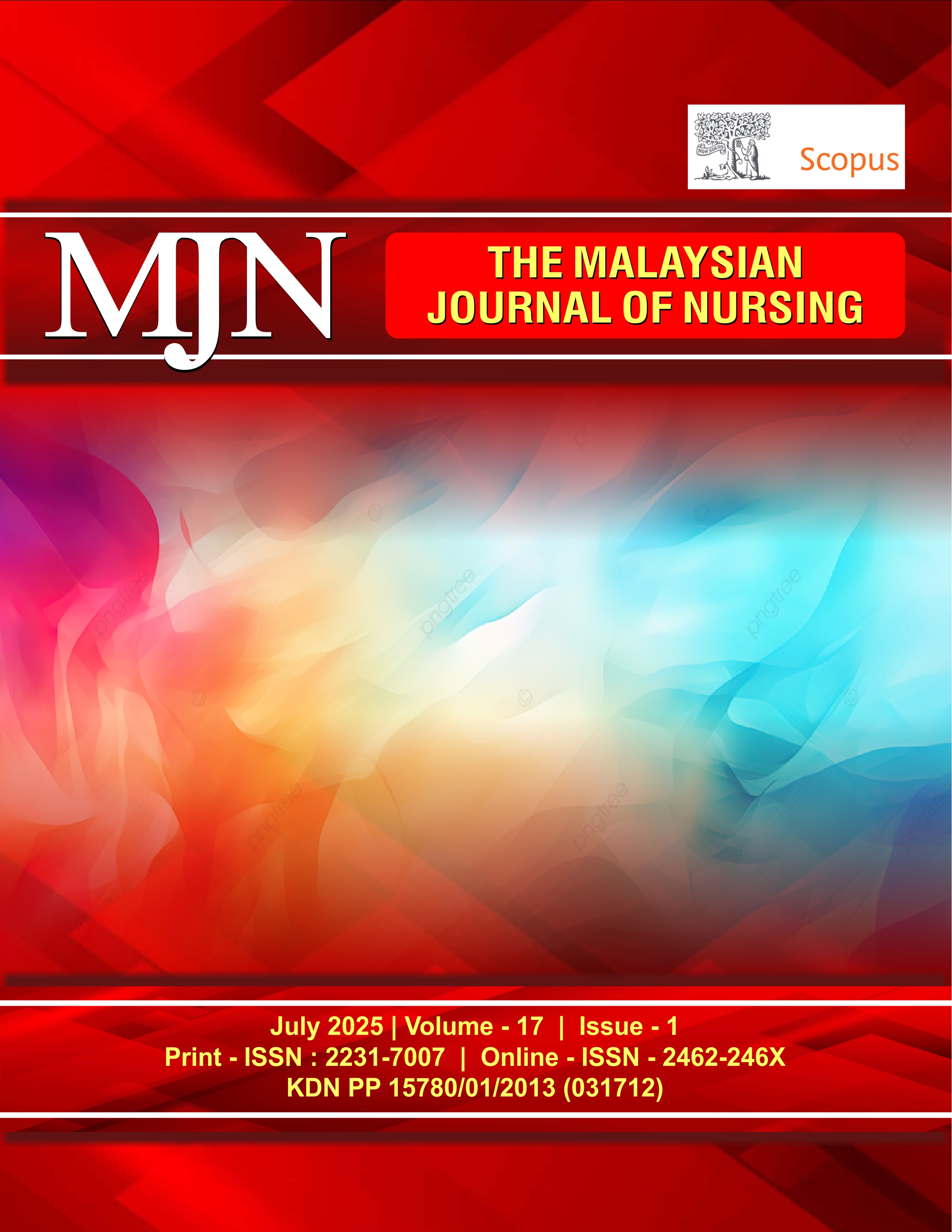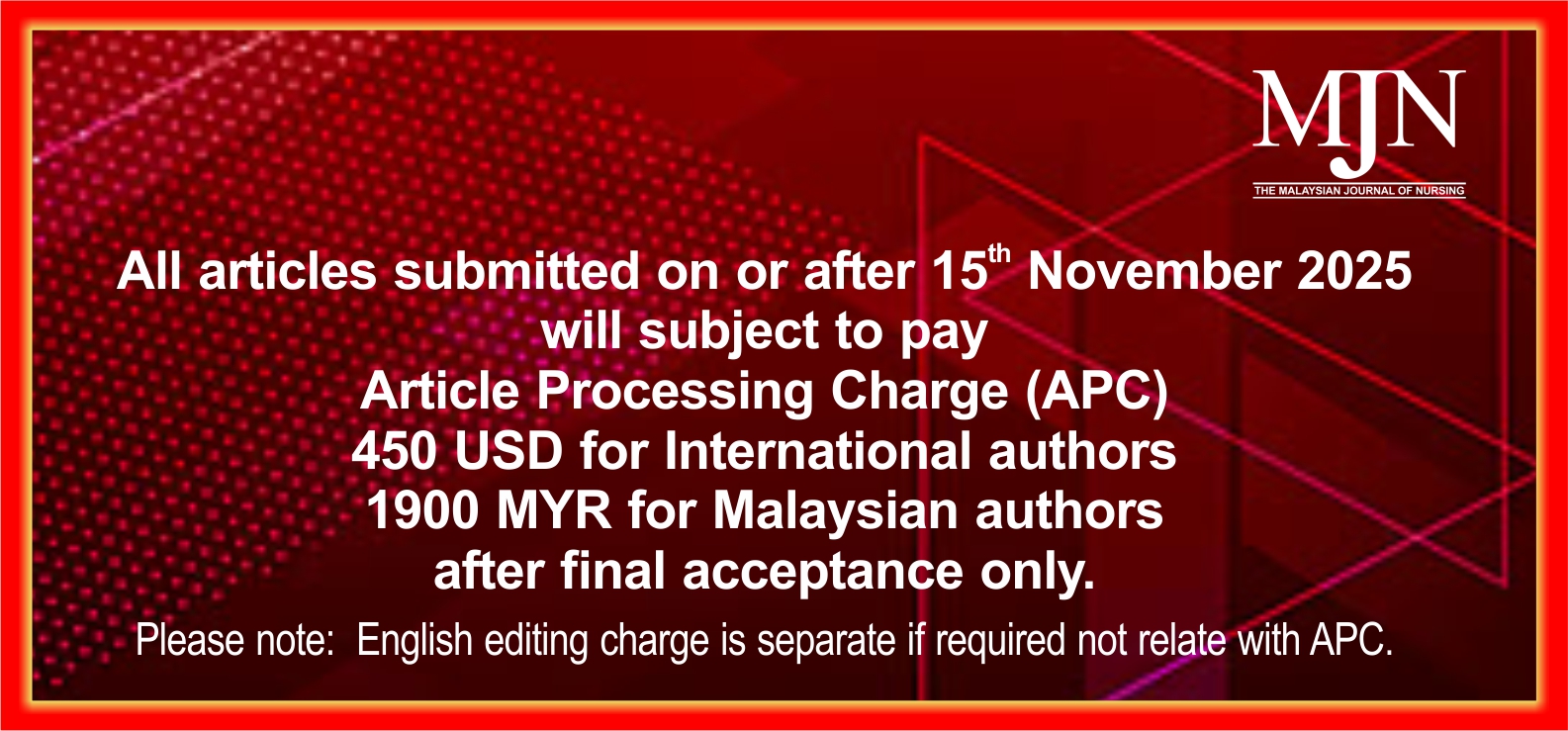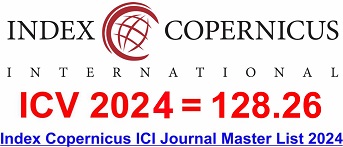Effectiveness of Lamaze Technique for Parturient on Pain Intensity and Labour Progress at Women’s Health Hospital
DOI:
https://doi.org/10.31674/mjn.2025.v17i01.013Abstract
Background: Lamaze, as a non-pharmacological nursing technique, helps parturients physically and psychologically relax during labour, so the antenatal preparation led the parturient to relax, which decreased the pain. Labour proceeded more smoothly. Objective: Determine the effectiveness of the Lamaze technique for parturients in terms of pain intensity and labour progress. Methods: A randomised control trial. The study was conducted in the Women's Health Hospital's antenatal clinic and labour unit at Assiut University, Egypt. It started at the beginning of April 2023 and was completed by the end of March 2024 over a period of one year. A total of 150 pregnant women randomly divided equally into two groups of pregnant women enrolled based on eligibility criteria. Using three methods to collect data: The study employed a structured interviewing questionnaire, a Visual Analogue Scale, and a labour progress assessment checklist. Results: The study Findings show that there is a significant difference with a p-value of 0.021 between the study group and control group related to the level of pain, and the study group's labour progress was better than that of the control group. So, the Lamaze technique should be included in maternity nursing care to manage pain and improve labour progress. Conclusion: Applying the Lamaze technique for parturients during labour stages had a positive effect on lowering the intensity of labour pain and enhancing labour progress during labour. Applying an antenatal educational programme for all pregnant women to increase awareness and knowledge about the Lamaze technique.
Keywords:
Effectiveness, Labour Progress, Lamaze Technique, Pain Intensity, ParturientDownloads
References
Ahmed, S. M., Abd Elrahman, G. A., & Abdelaleem, M. A. (2023). Role of nursing care in providing pain relief for women in labour at woman's health hospital Assuit University: A Clinical Audit. Assiut Scientific Nursing Journal, 11(37), 43-55. https://doi.org/10.21608/asnj.2023.205522.1566
Alan Dikmen, H., Gönenç, İ. M., & Ataş, A. N. (2024). Effects of peanut ball use on perceived labor pain, fatigue, and mother’s perception of childbirth: a randomized controlled trial. Archives of Gynecology and Obstetrics, 311(6), 1579-1589. https://doi.org/10.1007/s00404-024-07656-2
Alizadeh-Dibazari, Z., Abbasalizadeh, F., Mohammad-Alizadeh-Charandabi, S., Jahanfar, S. & Mirghafourvand, M. (2024). Childbirth preparation and its facilitating and inhibiting factors from the perspectives of pregnant and postpartum women in Tabriz-Iran: A qualitative study. Reproductive Health, 21(1), 106. https://doi.org/10.1186/s12978-024-01844-8
Blackburn, S. T. (2018). Maternal, fetal, & neonatal physiology: A clinical perspective (5th ed.). Saunders.
El-Kurdy, R., Hassan, S. I., Hassan, N. F., & El-Nemer, A. (2017). Antenatal education on childbirth self-efficacy for Egyptian primiparous women: A randomized control trial. IOSR Journal of Nursing and Health Science, 6(4), 15-23. https://doi.org/10.9790/1959-0604021523
Fumagalli, S., Borrelli, S., Bulgarelli, M., Zanoni, A., Serafini, M., Colciago, E., & Nespoli, A. (2022). Coping strategies for labor pain, related outcomes and influencing factors: A systematic review. European Journal of Midwifery, 6(November), 1-13. https://doi.org/10.18332/ejm/156440
Inam, R., Zia, A., Zahra, R., & Safdar, A. (2021). Breathing exercise as prenatal education during primigravida and its effect on labor pain. International Health Review, 1(2), 1-12. https://doi.org/10.32350/ihr.0102.01
Issac, A., Nayak, S. G., Priyadarshini, T., Balakrishnan, D., Halemani, K., Mishra, P., ... & Stephen, S. (2023). Effectiveness of breathing exercise on the duration of labour: A systematic review and meta-analysis. Journal of Global Health, 13. https://doi.org/10.7189/jogh.13.04023
Ji, C., Zhao, J., Nie, Q., & Wang, S. (2024). The role and outcomes of music therapy during pregnancy: A systematic review of randomized controlled trials. Journal of Psychosomatic Obstetrics & Gynecology, 45(1). https://doi.org/10.1080/0167482X.2023.2291635
Kaple, G. S., & Patil, S. (2023). Effectiveness of Jacobson relaxation and Lamaze breathing techniques in the management of pain and stress during labor: an experimental study. Cureus, 15(1). https://doi.org/10.7759/cureus.33212
Karkada, S. (2023) Impact of Lamaze breathing on natural childbirth: Comparison between primigravid and multigravid Women. Nursing Journal of India, CXIV, 29–31. https://doi.org/10.48029/nji.2023.cxiv106
Karkada, S. R., Noronha, J. A., & Bhat, S. K. (2024). Impact of lamaze breathing on childbirth comparison between primigravid and Multigravid Women. National Journal of Community Medicine, 15(06), 483-486. https://doi.org/10.55489/njcm.150620243901
Katz, J., & Melzack, R. (2024). McGill Pain Questionnaire. In Encyclopedia of Quality of Life and Well-Being Research (pp. 4194-4197). Cham: Springer International Publishing. http://dx.doi.org/10.1007/978-3-031-17299-1_1748
Koutoukidis, G., Hughson, J., & Stainton, K. (Eds.). (2012). Tabbner's nursing care: Theory and practice (6th ed.). Churchill Livingstone Australia. Retrieved from https://static.booktopia.com.au/pdf/9780729541145-1.pdf. Accessed on 24th November 2023.
Lai, C.Y., Wong, M.K.W., Tong, W.H., Chu, S.Y., Lau, K.Y., Tan, A.M.L., Hui, L.L., Lao, T.T.H. & Leung, T.Y. (2021). Effectiveness of a childbirth massage programme for labour pain relief in nulliparous pregnant women at term: a randomised controlled trial. Hong Kong Medical Journal, 27(6), 405–412. https://doi.org/10.12809/hkmj208629
Leutenegger, V., Wieber, F., Daly, D., Sultan-Beyer, L., Bagehorn, J., & Pehlke-Milde, J. (2024). Study protocol of a breathing and relaxation intervention included in antenatal education: A randomised controlled trial (BreLax study). Plos One, 19(10). https://doi.org/10.1371/journal.pone.0308480
Marzouk, T., & Emarah, H. A. (2019). Effectiveness of breathing exercise on reducing pain perception and state anxiety among primi parturients. IOSR Journal of Nursing and Health Science (IOSR-JNHS), 8(2), 15-22. https://doi.org/10.9790/1959-0802041522
Mohamed, Z., Aboud, S., Emam, A., & Abd-Elmordy, Z. (2024). Effect of Lamaze technique on labor pain and women’s satisfaction during first stage of labor. Benha Journal of Applied Sciences, 9(4), 17–28. https://doi.org/10.21608/bjas.2024.270428.1337
Pawale, M. P., & Salunkhe, J. A. (2020). Effectiveness of back massage on pain relief during first stage of labor in primi mothers admitted at a Tertiary care center. Journal of Family Medicine and Primary Care, 9(12), 5933-5938. https://doi.org/10.4103/jfmpc.jfmpc_1189_20
Ramdan, E. G., Ibrahim, W. A., Essa, R. M., & Khalil, M. H. (2022). Effect of third trimester lamaze preparation on labor pain intensity and pregnancy outcome. Alexandria Scientific Nursing Journal, 24(2), 50-59. https://doi.org/10.21608/asalexu.2022.248621
Thomson, G., Feeley, C., Moran, V. H., Downe, S., & Oladapo, O. T. (2019). Women’s experiences of pharmacological and non-pharmacological pain relief methods for labour and childbirth: A qualitative systematic review. Reproductive Health, 16(1), 1-20. https://doi.org/10.1186/s12978-019-0735-4
World Health Organization (WHO). (2022) Births attended by skilled health personnel (%) (SDG indicator 3.1.2). The Global Health Observatory. Retrieved from: https://www.who.int/data/gho/indicator-metadata-registry/imr-details/25. Accessed on 15th December, 2023.
Wu, C., Ge, Y., Zhang, X., Du, Y., He, S., Ji, Z., & Lang, H. (2021). The combined effects of Lamaze breathing training and nursing intervention on the delivery in primipara: A PRISMA systematic review meta-analysis. Medicine, 100(4). https://doi.org/10.1097/md.0000000000023920
Yasmin, M., Yasmeen, M. & Yasmin, R. (2024) The Impact of Breathing Exercises on Labor Duration and Maternal Anxiety in pregnant women. Biological and Clinical Sciences Research Journal, 2024(1). https://doi.org/10.54112/bcsrj.v2024i1.1048
Yohai, D., Alharar, D., Cohen, R., Kaltian, Z., Aricha-Tamir, B., Ben Aion, S.B., Yohai, Z. & Weintraub, A.Y. (2018). The effect of attending a prenatal childbirth preparedness course on labor duration and outcomes. Journal of Perinatal Medicine, 46(1), 47-52. https://doi.org/10.1515/jpm-2016-0345
Published
How to Cite
Issue
Section
License
Copyright (c) 2025 The Malaysian Journal of Nursing (MJN)

This work is licensed under a Creative Commons Attribution-NonCommercial-NoDerivatives 4.0 International License.



































